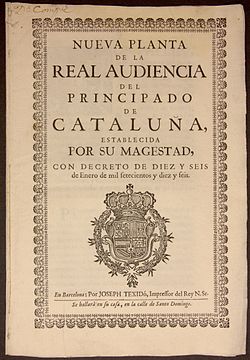


The Nueva Planta decrees (Spanish: Decretos de Nueva Planta, Catalan: Decrets de Nova Planta, English: "Decrees of the New Plant")[a] were a number of decrees signed between 1707 and 1716 by Philip V, the first Bourbon King of Spain, during and shortly after the end of the War of the Spanish Succession by the Treaty of Utrecht.
The Decrees put an end to the existence of the realms of the Crown of Aragon (Aragon, Catalonia, Valencia and Majorca) as separate states within a composite monarchy and incorporated them into the Crown of Castile, thus abolishing the political differences of the two crowns and essentially establishing the Kingdom of Spain as a French-style absolute monarchy and a centralized state in the pre-liberal sense.
Angered by what he saw as sedition by the realms of the Crown of Aragon, who had supported the claim of Charles of Austria to the Spanish thrones during the war and taking his native France as a model of a centralised state, Philip V suppressed the institutions, privileges, and the ancient charters (Spanish: fueros, Catalan: furs) of almost all the areas that were formerly part of the Crown of Aragon, the Kingdom of Aragon, the Principality of Catalonia, the Kingdom of Valencia, and the Kingdom of Majorca. The decrees ruled that all the territories in the Crown of Aragon except the Aran Valley were to be ruled by the laws of Castile ("the most praiseworthy in all the Universe" according to the 1707 decree), embedding those regions into a new and nearly uniformly administered, centralised Spain.
The other historic territories (Navarre and the other Basque territories) supported Philip V initially, whom they saw as belonging to the lineage of Henry III of Navarre, but after Philip V's military campaign to crush the Basque uprising, he backed down on his intent to suppress home rule.
The acts abolishing the charters were promulgated in 1707 in the kingdoms of Valencia and Aragon,[1] in 1715 in the Kingdom of Majorca and in 1716 in the Principality of Catalonia.[2]
The decrees effectively created a centralized Spanish state and Spanish citizenship by abolishing all legal distinctions between the Castilians and the Aragonese, Catalans, Valencians and Majorcans. One of the main goals of the decrees was the replacement of the administrative and public law of each state of the Crown of Aragon. The consequence was the abolition of the political institutions that they developed over the previous centuries, including their representative and legislative bodies, the Courts of Aragon, the Courts of Catalonia and the Courts of Valencia. From that point on, the members of the abolished Courts were summoted to the Cortes of Castile, now operating as the unified Cortes of Spain, except in Navarra.
The decrees erased all internal borders and tariffs except for the Basque territory and granted all citizens of the newly created Spanish state the right to trade with the American and Asian colonies, which henceforth were no longer the exclusive domain of the Crown of Castile.
The top civil servants were to be appointed directly from Madrid, and most institutions in what had become subnational entities were abolished. Court cases could also be presented and argued only in Castilian, which became the sole language of government and displaced Latin, Catalan and the other languages of Spain. However, the application of Castilian as a single administrative language had one exception in the Vizcaya Chamber of the Valladolid Court, where the use of Basque was permitted <https://web.archive.org/web/20070703081650/http://www.snae.org/badator.es.php>.
| Authority control databases: National |
|
|---|